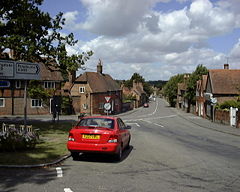Our website is made possible by displaying online advertisements to our visitors.
Please consider supporting us by disabling your ad blocker.
Aldermaston
| Aldermaston | |
|---|---|
 The Street, Aldermaston | |
Location within Berkshire | |
| Area | 13.4 km2 (5.2 sq mi) |
| Population | 1,015 (2011 census)[1] |
| • Density | 76/km2 (200/sq mi) |
| OS grid reference | SU5965 |
| • London | 46 miles (74 km) |
| Civil parish |
|
| Unitary authority | |
| Ceremonial county | |
| Region | |
| Country | England |
| Sovereign state | United Kingdom |
| Post town | Reading |
| Postcode district | RG7 |
| Dialling code | 0118 |
| Police | Thames Valley |
| Fire | Royal Berkshire |
| Ambulance | South Central |
| UK Parliament | |
Aldermaston (UK: /ˈɔːldərmɑːstən/ AWL-dər-mah-stən)[2] is a village and civil parish in Berkshire, England. In the 2011 census, the parish had a population of 1,015.[3] The village is in the Kennet Valley and bounds Hampshire to the south. It is approximately 8 miles (13 km) from Newbury, Basingstoke, and Reading and is 46 miles (74 km) from London.
Aldermaston may have been inhabited as early as 1690 BCE; a number of postholes and remains of cereal grains have been found in the area. Written history of the village is traced back at least as far as the 9th century CE, when the Anglo-Saxon Chronicles showed that the Ealdorman of Berkshire had his country estate in the village. The manor of Aldermaston was established by the early 11th century, when the village was given to the Achard family by Henry I; the manor is documented in the Domesday Book of 1086. St Mary the Virgin Church was established in the 13th century, and some of the original Norman architecture remains in the building's structure. The last resident Lord of the Manor, Charles Keyser, died in 1929. Aldermaston Court, the manor estate and house, was requisitioned for armed forces use during the Second World War.
The name "Aldermaston" is well known in connection with the UK's nuclear weapons programme, as well as the Campaign for Nuclear Disarmament. The Atomic Weapons Establishment (AWE), which develops, maintains, and disposes of the UK's nuclear weaponry is in the parish. Built on the site of the former RAF Aldermaston, the plant has been the destination of numerous Aldermaston Marches.
- ^ Cite error: The named reference
ONS 2011was invoked but never defined (see the help page). - ^ Pointon, GE, ed. (1983). BBC pronouncing dictionary of British names (2nd ed.). Oxford: Oxford University Press. ISBN 0192129767.
- ^ Office for National Statistics (2010). "West Berkshire (Unitary Authority) (Neighbourhood Statistics)". London. Archived from the original on 22 June 2011. Retrieved 16 April 2011.
Previous Page Next Page



